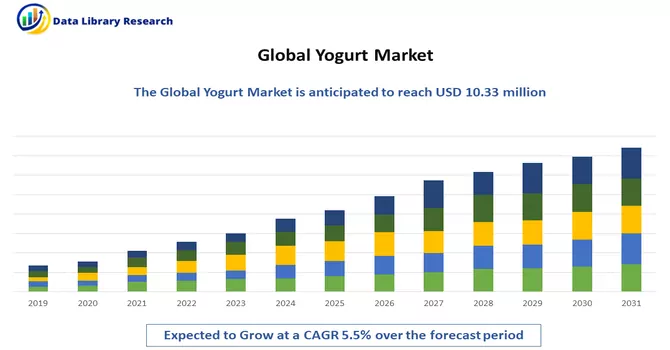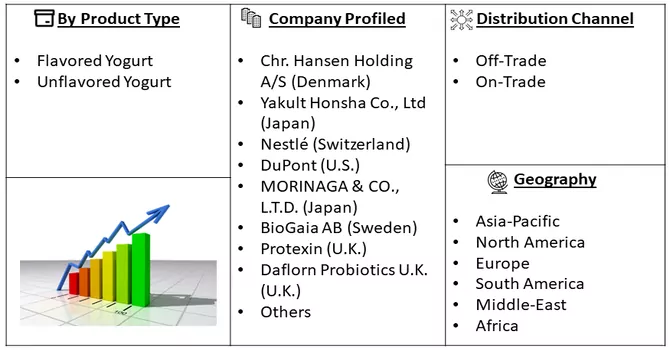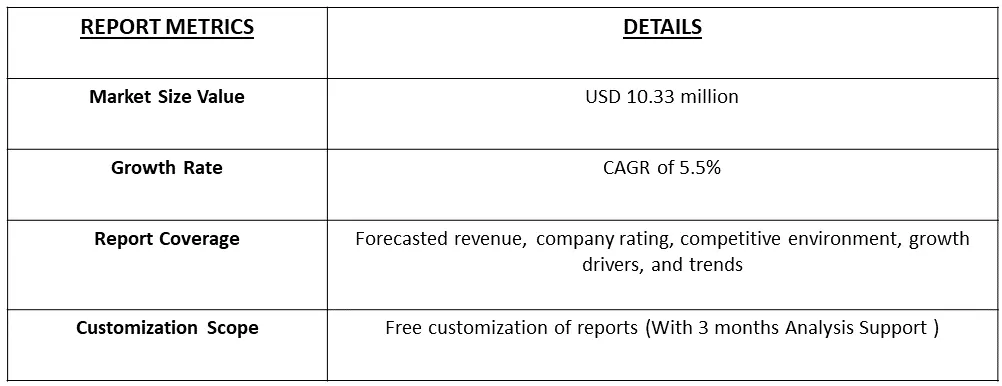The global Yogurt market was valued at USD 10.33 million in 2023 and is projected to a CAGR of 5.5% from 2024 to 2031.

Get Complete Analysis Of The Report - Download Free Sample PDF
Yogurt, a dairy product resulting from the bacterial fermentation of milk, typically with lactic acid bacteria like Lactobacillus bulgaricus and Streptococcus thermophilus, undergoes a process that thickens it, imparting a creamy texture and tangy flavor. Enjoyed worldwide, yogurt is renowned for its probiotic content, promoting digestive health and serving as a versatile food item in various culinary applications. The yogurt market is witnessing substantial growth driven by multiple factors. Increased consumer awareness of yogurt's health benefits, including probiotics for gut health and essential nutrients like calcium and protein, is a significant contributor.
The growing demand for convenient and nutritious snacks further fuels market expansion, with yogurt being a portable and adaptable choice for on-the-go consumption. Innovation plays a pivotal role in the market's evolution, with the introduction of diverse yogurt formulations, including non-dairy alternatives like almond, soy, and coconut yogurt. This caters to varying dietary preferences such as vegan, lactose-free, and gluten-free diets, broadening the consumer base. Moreover, the development of flavored and indulgent yogurt varieties, coupled with marketing efforts emphasizing yogurt's role in weight management and overall well-being, sparks consumer interest and propels market growth. Expansion into emerging markets and strategic product diversification also contribute to the dynamic growth trajectory of the global yogurt industry.
The Global Yogurt market is experiencing notable trends that shape its dynamics in 2024. A prominent driver is the heightened consumer awareness regarding the health benefits associated with yogurt consumption. The recognition of yogurt as a rich source of probiotics that support digestive health, while providing essential nutrients like calcium and protein, is steering market growth. The demand for convenient and nutritious snack options is another key trend propelling the Global Yogurt market. Yogurt's portability and versatility make it an ideal on-the-go choice, aligning with the evolving lifestyle preferences of consumers seeking both health and convenience in their dietary choices. An innovative wave in yogurt formulations is evident, with a surge in non-dairy alternatives such as almond, soy, and coconut yogurt.
This diversification caters to a broad spectrum of dietary preferences, including vegan, lactose-free, and gluten-free diets, expanding the market's consumer base. Flavor and indulgence are becoming focal points for product development, with a range of enticing and indulgent yogurt varieties gaining popularity. Marketing strategies emphasizing yogurt's role in weight management and overall well-being are further amplifying consumer interest, contributing to market growth. Global expansion into emerging markets and strategic product diversification strategies are also noteworthy trends, underscoring the industry's adaptability and responsiveness to evolving consumer preferences. These trends collectively contribute to the vibrant and dynamic landscape of the Global Yogurt market.
Market Segmentation: The Yogurt Market is segmented by Product Type (Flavored Yogurt, Unflavored Yogurt), by Distribution Channel (Off-Trade, On-Trade) and by Region (Africa, Asia-Pacific, Europe, Middle East, North America, South America). Market Value in USD and Volume are both presented. Key Data Points observed include Per capita consumption; Population; and Dairy production.

For Detailed Market Segmentation - Download Free Sample PDF
Market Drivers:
Rising popularity of low-fat desserts
The global yogurt market is set to experience a boost, driven by the increasing favorability towards low-fat and low-sugar desserts. Additionally, the surging demand for alternative ice cream options, particularly favored by children, and the growing awareness among consumers about health considerations are macroeconomic factors that contribute positively to the industry. This rising popularity of low-fat and low-sugar desserts signifies a notable trend, as consumers increasingly seek healthier options without compromising on taste. The market is responding to this demand by introducing a variety of yogurt products tailored to meet these specific nutritional preferences. Moreover, the inclination towards refreshing ice cream alternatives, especially among the younger demographic, is creating a significant market niche. As parents and caregivers become more health-conscious, they are opting for yogurt-based alternatives that provide a balance between taste and nutritional value. The macroeconomic factor of increased consumer health awareness is influencing purchasing decisions, with individuals actively seeking products that align with their wellness goals. This shift in mindset bodes well for the yogurt market, encouraging innovation in product formulations and marketing strategies to cater to the health-conscious consumer segment. Thus, the convergence of these factors is creating a positive trajectory for the global yogurt market, with a focus on healthier options and alternatives gaining prominence in response to evolving consumer preferences and awareness.
Rising disposable income and rising urbanisation
The simultaneous trends of rising disposable income and increasing urbanization have significantly impacted the consumption patterns of yogurt. As disposable incomes increase, consumers often have more room in their budgets for diverse and premium food choices, and yogurt, with its versatile and health-oriented image, has become a popular option. With urbanization on the rise, there is a noticeable shift in lifestyle and dietary habits. Urban dwellers often seek convenient and nutritious food options that align with their busy schedules. Yogurt, being a convenient and portable source of essential nutrients, fits well into this lifestyle. Its versatility allows it to be consumed on its own as a snack or incorporated into various dishes and recipes. The convenience of pre-packaged yogurt cups and on-the-go formats caters to the fast-paced urban lifestyle. Yogurt's perceived health benefits, such as being a good source of probiotics, calcium, and protein, also align with the wellness-conscious choices that urban consumers increasingly prioritize.i Moreover, the availability and variety of yogurt products have expanded in urban markets, with different flavors, formulations, and even dairy-free options to cater to diverse preferences. Yogurt has become a staple in the modern urban diet, appreciated not only for its taste but also for its perceived health attributes. Thus, the rising disposable income and urbanization trends have led to an increased adoption of yogurt as a versatile and health-conscious food choice, reflecting the evolving preferences of consumers in urbanized environments.
Market Restraints:
The yogurt market faces several restraints, including the impact of fluctuating milk prices on production costs, which can influence the pricing of yogurt products and potentially affect profit margins for manufacturers. Changing consumer perceptions regarding sugar content and additives in flavored yogurts have led to increased demand for healthier, less sweet options, posing a challenge for brands that rely heavily on traditional yogurt varieties. Furthermore, the perishable nature of yogurt necessitates stringent cold chain logistics, which can increase distribution costs and limit market accessibility, especially in regions with underdeveloped infrastructure. Intense competition among market players and the saturation of mature markets also pose challenges for new entrants and may hinder overall market growth. Additionally, the emergence of alternative plant-based yogurts, driven by the growing popularity of dairy-free and vegan lifestyles, adds competitive pressure to traditional dairy yogurt producers. Successfully addressing these restraints requires strategic product innovation, sustainable sourcing practices, and effective marketing strategies to meet evolving consumer preferences and market demands.
The yogurt market underwent significant repercussions due to the COVID-19 pandemic, marked by disruptions in supply chains, shifts in consumer behavior, and economic uncertainties. The imposition of lockdowns and restrictions had a notable impact on out-of-home consumption of yogurt products, particularly affecting foodservice establishments. Concurrently, the retail sector experienced a surge in demand for durable and staple goods during the initial phases of the pandemic, temporarily boosting sales of shelf-stable products at the expense of perishable dairy items like yogurt. Economic downturns further influenced consumer spending habits, prompting some individuals to opt for more budget-friendly options. However, amidst these challenges, there were positive shifts. The pandemic acted as a catalyst for the accelerated adoption of e-commerce channels in the purchase of groceries, including yogurt. Consumers, seeking convenient and contactless shopping options, turned to online platforms. Despite the hurdles faced, the yogurt market demonstrated resilience. The long-term impact will hinge on the industry's ability to adapt to evolving consumer preferences, ensure supply chain resilience, and navigate the economic recovery in the post-pandemic landscape.
Segmental Analysis:
Flavoured Yogurt Segment is Expected to Witness Significant Growth Over the Forecast Period Flavored
Yogurt has become a prominent and diverse category within the dairy industry, offering consumers a wide array of taste experiences. The market features an extensive range of flavors, catering to various preferences and palates, with popular options including fruit-infused varieties like strawberry, blueberry, and mango, as well as indulgent choices such as vanilla and chocolate. This segment has witnessed continuous innovation, with manufacturers introducing unique and exotic flavor combinations to captivate consumer interest. Flavored yogurt not only serves as a delicious standalone snack but also adds versatility to culinary applications, making it a versatile and sought-after product in the dairy market. The evolving landscape of flavored yogurt reflects the dynamic nature of consumer taste preferences and the industry's commitment to meeting the demands of a diverse and discerning market.
On-Trade retail Segment is Expected to Witness Significant Growth Over the Forecast Period
Online retail giants like Amazon, Sainsbury’s, Asda, and Tesco have become dominant forces in the global grocery market, including dairy products such as yogurt. Leveraging marketing strategies like group buying, live streaming events, and enticing discounts, these platforms attract consumers to engage in e-commerce for their grocery needs. Group buying initiatives harness collective purchasing power for better deals, live streaming provides interactive product experiences, and discounts create incentives for online shopping. The convenience of ordering and doorstep delivery has further accelerated the adoption of online channels for yogurt purchases, reflecting a significant shift in consumer behavior towards e-commerce in the grocery sector.
Asia-Pacific Region is Expected to Witness Significant Growth Over the Forecast Period
In 2022, the Asia-Pacific region emerged as the leading yogurt market, capturing a significant value share. The off-trade channel dominated yogurt consumption, and a substantial growth of 10.68% is anticipated in 2023, driven by the widespread availability of diverse yogurt options in retail and foodservice channels. Supermarkets, accounting for 61.43% of the off-trade segment, played a crucial role, with major chains like Maruetsu, Aldi, Big Bazaar, Woolworths Group, and Aeon Retail offering an extensive range of imported and locally produced yogurt varieties. Globally, the yogurt distribution channel experienced a 4.57% growth in 2022, attributed to the abundance of yogurt flavors and a wide variety of brands. In the United States, the largest yogurt market in North America, preferences in 2021 leaned towards strawberry (8%), followed by vanilla and blueberry (both 4%), peach (3%), and mango (2%). Looking forward, the North American yogurt market is poised for a 5.08% growth in 2025, emphasizing the sustained demand for diverse distribution channels in the region.

Get Complete Analysis Of The Report - Download Free Sample PDF
The analyzed market exhibits a high degree of fragmentation, primarily attributable to the presence of numerous players operating on both a global and regional scale. The competitive landscape is characterized by a diverse array of companies, each contributing to the overall market dynamics. This fragmentation arises from the existence of specialized solution providers, established industry players, and emerging entrants, all vying for market share. The diversity in market participants is underscored by the adoption of various strategies aimed at expanding company presence. On a global scale, companies within the studied market are strategically positioning themselves through aggressive expansion initiatives. This often involves entering new geographical regions, targeting untapped markets, and establishing a robust global footprint. The pursuit of global expansion is driven by the recognition of diverse market opportunities and the desire to capitalize on emerging trends and demands across different regions. Simultaneously, at the regional level, companies are tailoring their approaches to align with local market dynamics. Regional players are leveraging their understanding of specific market nuances, regulatory environments, and consumer preferences to gain a competitive edge. This regional focus allows companies to cater to the unique needs of local clientele, fostering stronger market penetration. To navigate the complexities of the fragmented market, companies are implementing a range of strategies. Some of the key market players are:
Recent Development :
1) July 2022: Amul announced an investment of USD 60 million to build a new dairy plant in Rajkot to expand its production capabilities across milk, yogurt, and buttermilk products.
2) June 2022: Danone North America partnered with White Plains, Boulder, and Colo and launched Activia+ Multi-Benefit Probiotic Yogurt Drinks.
Q1. What was the Yogurt Market size in 2023?
As per Data Library Research the global Yogurt market was valued at USD 10.33 million in 2023.
Q2. At what CAGR is the Yogurt market projected to grow within the forecast period?
Yogurt market is projected to a CAGR of 5.5% over the forecast period.
Q3. What are the factors driving the Yogurt market?
Key factors that are driving the growth include the Rising popularity of low-fat desserts and Rising disposable income and rising urbanisation.
Q4. Which region has the largest share of the Yogurt market? What are the largest region's market size and growth rate?
Asia-Pacific has the largest share of the market. For detailed insights on the largest region's market size and growth rate request a sample here.
Data Library Research are conducted by industry experts who offer insight on industry structure, market segmentations technology assessment and competitive landscape (CL), and penetration, as well as on emerging trends. Their analysis is based on primary interviews (~ 80%) and secondary research (~ 20%) as well as years of professional expertise in their respective industries. Adding to this, by analysing historical trends and current market positions, our analysts predict where the market will be headed for the next five years. Furthermore, the varying trends of segment & categories geographically presented are also studied and the estimated based on the primary & secondary research.
In this particular report from the supply side Data Library Research has conducted primary surveys (interviews) with the key level executives (VP, CEO’s, Marketing Director, Business Development Manager and SOFT) of the companies that active & prominent as well as the midsized organization
FIGURE 1: DLR RESEARH PROCESS

Extensive primary research was conducted to gain a deeper insight of the market and industry performance. The analysis is based on both primary and secondary research as well as years of professional expertise in the respective industries.
In addition to analysing current and historical trends, our analysts predict where the market is headed over the next five years.
It varies by segment for these categories geographically presented in the list of market tables. Speaking about this particular report we have conducted primary surveys (interviews) with the key level executives (VP, CEO’s, Marketing Director, Business Development Manager and many more) of the major players active in the market.
Secondary ResearchSecondary research was mainly used to collect and identify information useful for the extensive, technical, market-oriented, and Friend’s study of the Global Extra Neutral Alcohol. It was also used to obtain key information about major players, market classification and segmentation according to the industry trends, geographical markets, and developments related to the market and technology perspectives. For this study, analysts have gathered information from various credible sources, such as annual reports, sec filings, journals, white papers, SOFT presentations, and company web sites.
Market Size EstimationBoth, top-down and bottom-up approaches were used to estimate and validate the size of the Global market and to estimate the size of various other dependent submarkets in the overall Extra Neutral Alcohol. The key players in the market were identified through secondary research and their market contributions in the respective geographies were determined through primary and secondary research.
Forecast Model
